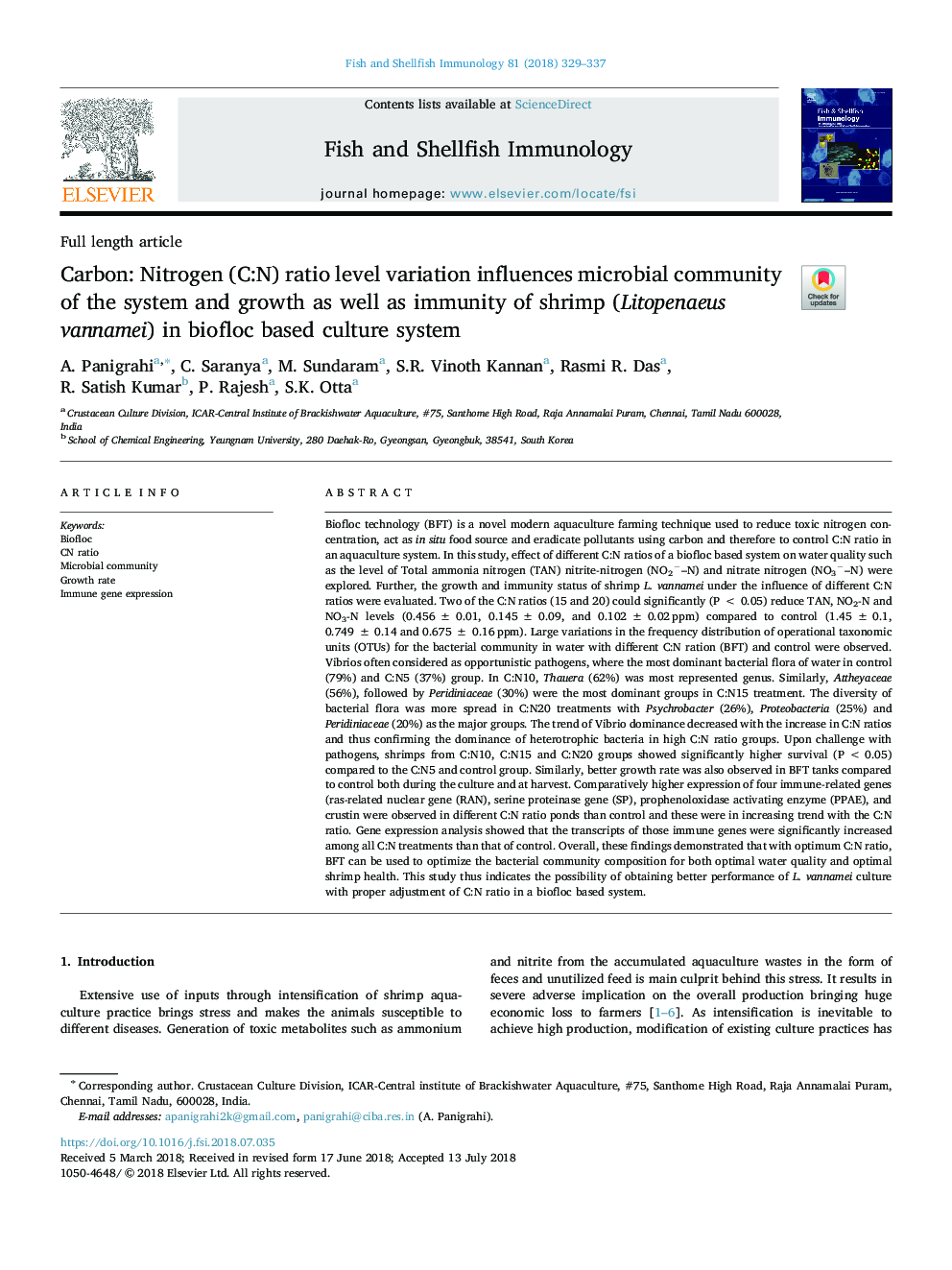| کد مقاله | کد نشریه | سال انتشار | مقاله انگلیسی | نسخه تمام متن |
|---|---|---|---|---|
| 8498141 | 1553593 | 2018 | 9 صفحه PDF | دانلود رایگان |
عنوان انگلیسی مقاله ISI
Carbon: Nitrogen (C:N) ratio level variation influences microbial community of the system and growth as well as immunity of shrimp (Litopenaeus vannamei) in biofloc based culture system
دانلود مقاله + سفارش ترجمه
دانلود مقاله ISI انگلیسی
رایگان برای ایرانیان
کلمات کلیدی
موضوعات مرتبط
علوم زیستی و بیوفناوری
علوم کشاورزی و بیولوژیک
علوم آبزیان
پیش نمایش صفحه اول مقاله

چکیده انگلیسی
Biofloc technology (BFT) is a novel modern aquaculture farming technique used to reduce toxic nitrogen concentration, act as in situ food source and eradicate pollutants using carbon and therefore to control C:N ratio in an aquaculture system. In this study, effect of different C:N ratios of a biofloc based system on water quality such as the level of Total ammonia nitrogen (TAN) nitrite-nitrogen (NO2â-N) and nitrate nitrogen (NO3â-N) were explored. Further, the growth and immunity status of shrimp L. vannamei under the influence of different C:N ratios were evaluated. Two of the C:N ratios (15 and 20) could significantly (Pâ¯<â¯0.05) reduce TAN, NO2-N and NO3-N levels (0.456â¯Â±â¯0.01, 0.145â¯Â±â¯0.09, and 0.102â¯Â±â¯0.02â¯ppm) compared to control (1.45â¯Â±â¯0.1, 0.749â¯Â±â¯0.14 and 0.675â¯Â±â¯0.16â¯ppm). Large variations in the frequency distribution of operational taxonomic units (OTUs) for the bacterial community in water with different C:N ration (BFT) and control were observed. Vibrios often considered as opportunistic pathogens, where the most dominant bacterial flora of water in control (79%) and C:N5 (37%) group. In C:N10, Thauera (62%) was most represented genus. Similarly, Attheyaceae (56%), followed by Peridiniaceae (30%) were the most dominant groups in C:N15 treatment. The diversity of bacterial flora was more spread in C:N20 treatments with Psychrobacter (26%), Proteobacteria (25%) and Peridiniaceae (20%) as the major groups. The trend of Vibrio dominance decreased with the increase in C:N ratios and thus confirming the dominance of heterotrophic bacteria in high C:N ratio groups. Upon challenge with pathogens, shrimps from C:N10, C:N15 and C:N20 groups showed significantly higher survival (Pâ¯<â¯0.05) compared to the C:N5 and control group. Similarly, better growth rate was also observed in BFT tanks compared to control both during the culture and at harvest. Comparatively higher expression of four immune-related genes (ras-related nuclear gene (RAN), serine proteinase gene (SP), prophenoloxidase activating enzyme (PPAE), and crustin were observed in different C:N ratio ponds than control and these were in increasing trend with the C:N ratio. Gene expression analysis showed that the transcripts of those immune genes were significantly increased among all C:N treatments than that of control. Overall, these findings demonstrated that with optimum C:N ratio, BFT can be used to optimize the bacterial community composition for both optimal water quality and optimal shrimp health. This study thus indicates the possibility of obtaining better performance of L. vannamei culture with proper adjustment of C:N ratio in a biofloc based system.
ناشر
Database: Elsevier - ScienceDirect (ساینس دایرکت)
Journal: Fish & Shellfish Immunology - Volume 81, October 2018, Pages 329-337
Journal: Fish & Shellfish Immunology - Volume 81, October 2018, Pages 329-337
نویسندگان
A. Panigrahi, C. Saranya, M. Sundaram, S.R. Vinoth Kannan, Rasmi R. Das, R. Satish Kumar, P. Rajesh, S.K. Otta,